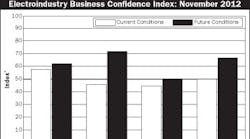Kaman Industrial Technologies (KIT), the industrial distribution business Kaman Corp., Bloomfield, Conn., has built up in recent acquisitions of Minarik, Zeller Electric and others, has entered into a national distributor agreement with Schneider Electric. KIT, one of the largest bearing and power transmission (PT) distributors in the United States, immediately becomes a distributor for Schneider Electric’s lines of industrial automation and control products as well as select power control and protection products commonly used in motor control applications.
It was the acquisition of Zeller Corp., Rochester, N.Y., in August that opened the door for KIT to forge a wider relationship with Schneider. KIT made a similar nationwide distribution agreement with fluid power giant Parker-Hannifin after acquiring Catching Fluidpower last year. Zeller was part of Schneider Electric’s ACE (automation and control excellence) Distributor program and had already set itself apart with a staff of engineers offering technical support to industrial customers. At the time of the Zeller deal, KIT President Steve Smidler said a deal with Schneider similar to Parker-Hannifin’s wasn’t the plan, and expressed the company’s support for manufacturers’ efforts to maintain distributor exclusivity, but Schneider executives separately expressed interest in an expanded relationship with KIT.
As part of the agreement, Schneider Electric will become KIT’s primary line of AC drives, sensors, low voltage controls and automation products. The deal also authorizes the sale of Schneider Electric programmable logic controllers (PLCs), human machine interface (HMI) systems and signaling equipment. KIT will begin stocking these products at its more than 200 locations throughout the U.S. in the first quarter of 2013. KIT’s authorization doesn’t include construction and industrial-grade power equipment such as NEMA-rated starters, heavy-duty disconnect switches and large circuit breakers.
The Schneider authorization gives Kaman three primary advantages, said Dave Mayer, KIT’s vice president, marketing: “One, a significant increase to our automation catalog and automation offering. There are very few products in the Schneider offering that we previously distributed. Two, a global platform. We believe our national accounts are really global accounts. They have global plants and global footprints and want a global automation system, rather than stitching together a sort of best-in-breed offering, which is what we were trying to do. Three, it’s a highly differentiated strategy. In the PT channel, this product line is not traditionally sold. Our competitors don’t have this offering, so we won’t be competing on price, we’ll be competing on getting Schneider placed at OEMs and at end users.”
Kaman previously had a mix of suppliers in the different product categories it has carried that will now be devoted to Schneider lines. It primarily sold Omron PLCs, which Smidler described as being optimized for OEM machine-building applications. Through the acquisition of Minarik, it added Panasonic PLCs and Red Lion HMI products. That approach was based on assembling “best-in-breed” technology at each point, but Smidler said machine builders often would rather have a comprehensive package where they can obtain support for all the technologies from one source.
Another advantage for Kaman is the greater access to safety technologies offered by Schneider, Smidler said. “Safety products are a great thing at the end-user level, because there’s all kinds of automation enhancement programs going on at end-users to comply with better employee safety standards,” he said. “Many of the capital projects that are being funded are in and around employee safety, so it gives us fabulous access to a portfolio of safety products.
The agreement also includes moves to bolster technical support KIT can offer customers. Schneider Electric will provide drives specialists to support a mutually agreed upon number of KIT branches. Each specialist is certified and will offer support and technical knowledge. KIT will be pulling together its technical specialists on the electrical side to support a nationwide Schneider team.
The deal is Schneider’s first big move into the PT and motion control market, which it estimates at $107 billion in the United States.
“Kaman provides a different entry point to our potential customers,” added Jeff Jervah, director of channel development for Schneider Electric’s Industry Business, in a release announcing the deal. “We look forward to working together to provide the power transmission market a comprehensive line of drives, controls, automation and sensors products from one supplier — an offer that is currently absent from the market.”
Smidler told Electrical Marketing this week that the process that led to KIT’s authorization began earlier this year when Schneider picked up ten independent manufacturers rep agencies that specialized in drives and other automation products after ABB changed its channel marketing plans to bring sales of drives in-house following its acquisition of Baldor motors.
“Schneider went out and picked up all those drives reps, and they needed a channel,” Smidler said. “That’s really how it started. They were talking to us, we believe they were talking to other bearing and PT distributors, and during that phase we just happened to buy Zeller. And oh, by the way, we’re the only bearing and PT guy that has an automation/high-speed closed-loop motion control business, with Minarik. So I’m sure when they looked at it, they said, ‘Okay, you guys are trying to be technically differentiated, you’ve already shown that you’ve invested heavily on the electrical side, mostly electrical motion control and some sensors on the Minarik side of the business.’ So it’s an interesting little web, how it came together.”
Kaman has been an interesting sort of conglomerate of businesses over the years since its founding in 1945, moving in and out of various kinds of distribution such as musical instruments, but has refined its focus to two core business lines. In addition to Industrial Distribution, it has Kaman Aerospace, a manufacturer of various helicopter systems that dates back to the company’s founding by Charles Kaman, a pioneer in development of rotary-wing aircraft.
The Kaman Q3 SEC 10-Q filing gave an outlook for the Industrial Distribution segment, projecting sales in the range of $1.04 billion to $1.055 billion.


